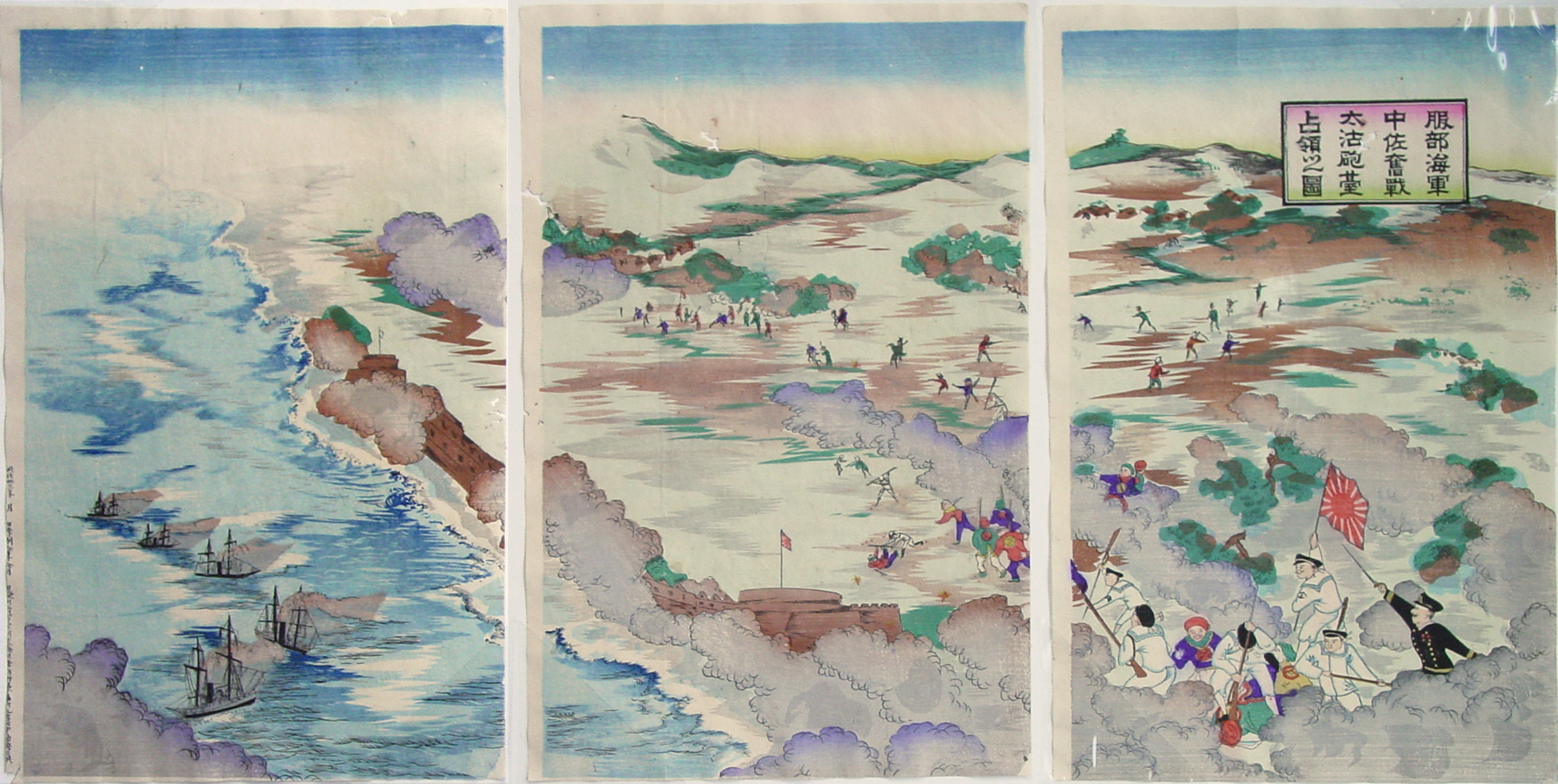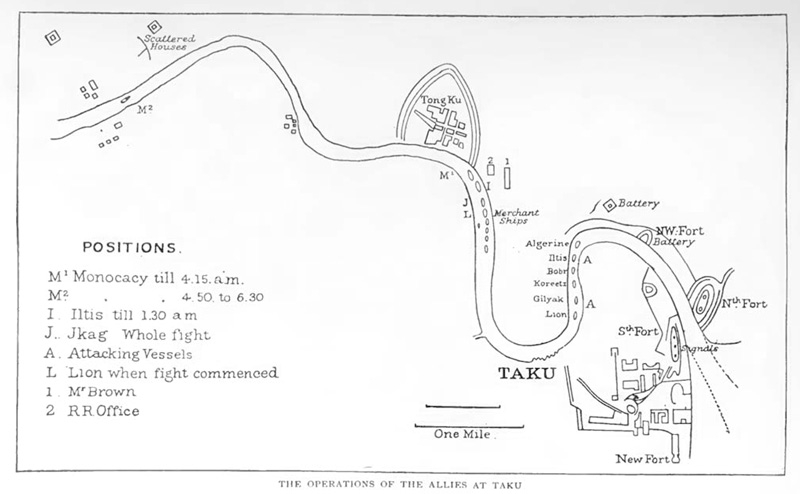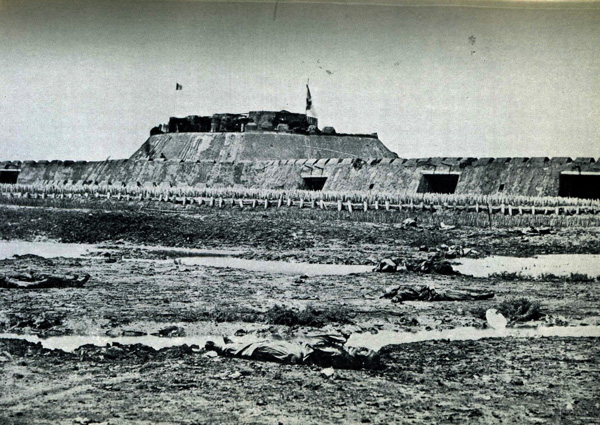About This Print
This 1900 Boxer Rebellion print gives us a bird's-eye view, through the smoke of the artillery shelling, of the attack on the Chinese Taku (Dagu) Forts. Lt. Colonel Hattori of the Japanese Navy, in black uniform with raised sword, is pictured directing the attack by Japanese troops on the North-West Fort. Stick-like figures scattered throughout the print show soldiers of the Eight Nation Alliance battling Chinese army and Boxer irregular forces. An account of the battle and Hattori's exploits follows. Hattori's rank is variously given in historical documents as commander, captain and lieutenant colonel. He was to die in the assault.For another print depicting Japanese troops during the Rebellion see Illustration of the the Army and Navy Protecting the Legations and Japanese Residents.
The Attack on the Taku Forts and Hattori's Actions
Source: China and the Allies, Arnold Henry Savage Landor, Scribner, 1901, p. 125-126 http://www.archive.org/stream/chinaallies01landuoft/chinaallies01landuoft_djvu.txt| Towards dawn the guns of the North-West Fort were sufficiently silenced to permit the approach of a storming party. The British and Italians fought side by side, leading the attack, and supported by contingents from other nations; but it appears that this advance was somewhat impeded by the heavy ground. The Russians, who were under the heavy fire of the Chinese, progressed slowly. The Japanese, occupying the rear, now came up with two field pieces, and joined in the final charge. Captain Hattori leading his men with remarkable bravery. Indeed, the little fellows were now at the head of the attacking force, having come up by the road giving access to the fort instead of by the swampy ground. The Chinese were still holding on with great tenacity, and keeping up a heavy fusillade. A bayonet charge was necessary to drive them out of their position. Captain Hattori, at the head of his men, rushed the fort, followed by the British and Italians. Captain Hattori himself, a most gallant officer, was shot dead when only a few yards from the parapet; but Lieutenant Shiraishi, a young man of equal pluck and determination, took immediate command, and led the men on. The Chinese were driven off. A pathetic incident took place. A Japanese sailor had climbed to the top of a flagstaff to put up the flag of the Rising Sun, when, unluckily, a Chinese bullet brought him down and killed him. Had it not been for this mishap, the Japanese flag would have been the first to fly on the fort; as it was, the British was hoisted immediately by the single halyard of the flagstaff. There can be no doubt, however, that the Japanese, immediately followed by the British and Italians, were the first to enter the fort, and sufficient praise cannot be given them for their bravery and military skill. |
"The first fort was taken by the Japanese, and the second by the British, and then the Germans and Russians secured the south fort.... After the forts were captured they were visited by the foreign officers. They presented a ghastly sight. The forts were one mass of ruins, and rivers of blood, mutilated bodies lying everywhere. The Chinese troops fled to Tientsin."1
Battle Map and Photo of the Taku Forts
The forts, built in 1816, lay along the Pei-Ho river and controlled access to points north and to Peking. To the Chinese the forts are a "heroic symbol of China's fight against foreign invasion [and] the emplacement is considered one of the three treasures of Tianjin by its people."2
| Battle map of Taku click on image to enlarge China and the Allies, Arnold Henry Savage Landor, Scribner, 1901, p. 123. | Taku forts after the battle click on image to enlarge |
The Boxer Rebellion - Two Sentence Summary
After sixty years of dismemberment by foreign powers, a Chinese secret society nicknamed the 'Boxers', clandestinely supported by the Chinese empress, moved to rid China of foreign domination. A series of murders of foreigners by the Boxers culminated in the siege of the international Legation Quarter in Beijing, which was finally lifted after two months by the troops of the Eight Nation Alliance.1 "The Boxer Rebellion as reported in the UK papers" http://freepages.genealogy.rootsweb.ancestry.com/~pbtyc/Boxer/Boxer.html
2 the website of China Art International Travels service Co,.Ltd http://www.beijing-travels.com/attractions/tianjin/dagu_fort.html
Print Details
| IHL Catalog | #514 |
| Title or Description | Illustration of the Occupation of the Taku Forts and the Hard Fight of Navy Lt. Colonel Hattori 服部海軍 中佐奮戦 太沽砲台 占領之図 Hattori kaigun chūsa funsen Taiko hōdai senryō no zu |
| Artist | Unknown |
| Signature | unsigned |
| Seal | not sealed |
| Publication Date | 1900 |
| Publisher | unknown - unread information on publisher is contained in the slightly trimmed left margin (see Miscellaneous below) |
| Carver | |
| Printer | |
| Impression | excellent |
| Colors | excellent |
| Condition | fair - some worm damage each panel and minor wrinkling; full size sheets and not backed |
| Genre | nishiki-e; senso-e |
| Miscellaneous | left margin inscription with date 明治卅三 and unread publishing information (click on image to enlarge) |
| Format | vertical oban triptych |
| H x W Paper | 14 1/2 x 9 3/4 in. (35.9 x 71.1 cm) each sheet |
| H x W Image | |
| Literature | Conflicts of Interest: Art and War in Modern Japan, Philip K. Hu, et. al., Saint Louis Museum of Art, 2016, p. 201, pl. 82 |
| Collections This Print | St. Louis Art Museum 793:2010a-c |
2/4/2021
3/7/2020




